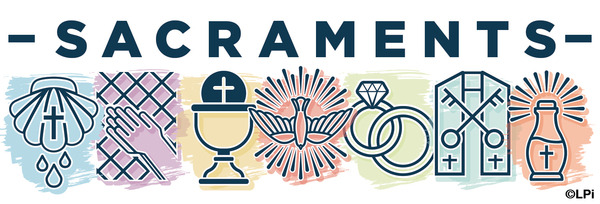sacraments
-
sacraments/Sacramentos

-
Sign of God's grace in our lives
We recognize that the Sacraments have a visible and invisible reality, a reality open to all the human senses but grasped in their God-given depths with the eyes of faith. When parents hug their children, for example, the visible reality we see is the hug. The invisible reality the hug conveys is love. We cannot "see" the love the hug expresses, although sometimes we can see its nurturing effect on the child.
The visible reality we see in the Sacraments is their outward expression, the form they take, and the way in which they are administered and received. The invisible reality we cannot "see" is God's grace, his gracious initiative in redeeming us through the death and Resurrection of his Son. His initiative is called grace because it is the free and loving gift by which he offers people a share in his life, and shows us his favor and will for our salvation. Our response to the grace of God's initiative is itself a grace or gift from God by which we can imitate Christ in our daily lives.
The saving words and deeds of Jesus Christ are the foundation of what he would communicate in the Sacraments through the ministers of the Church. Guided by the Holy Spirit, the Church recognizes the existence of Seven Sacraments instituted by the Lord. They are the Sacraments of Initiation (Baptism, Confirmation, the Eucharist), the Sacraments of Healing (Penance and the Anointing of the Sick), and the Sacraments at the Service of Communion (Marriage and Holy Orders). Through the Sacraments, God shares his holiness with us so that we, in turn, can make the world holier. (USCCB)
Gifts of God's grace in our lives
We recognize that the sacraments have a visible and invisible reality, a reality open to all human senses, but understood by the eyes of faith in the depth that God gives them. When parents embrace their children, for example, the visible reality is the embrace. The invisible reality of the embrace expresses love. We cannot "see" the love that the embrace expresses, although we sometimes see the emotional effect on the child.
The visible reality we see in the sacraments is their outward expression, the form they take and the way they are administered and received. The invisible reality that we cannot "see" is the grace of God, his generous initiative to redeem us through the death and resurrection of his Son. This initiative is called grace because it is the free and loving gift by which God offers his people a share in his life, and shows his favor and will for our salvation. Our response to the grace of God's initiative is itself a grace or gift from God by which we can imitate Christ in our daily lives.The saving words and works of Jesus Christ are the foundation for what he would communicate to us in the sacraments through the ministries of the Church. Guided by the Holy Spirit, the Church recognizes the existence of the seven sacraments instituted by the Lord. They are the sacraments of initiation (Baptism, Confirmation, and Eucharist), the sacraments of healing (Penance and Anointing of the Sick), and the sacraments of service (Matrimony and Holy Orders). Through the sacraments, God shares his holiness with us so that we, in turn, may make the world more holy. (USCCB)
-
Miscellaneous Sacramental Forms:
Sacramental Certificate Request Forms:
Sacramental Certificate Request English (Classic Form)
Sacramental Certificate Request English (Fillable Online Form)
Sacramental Certificate Request Spanish (Classic Form)
Sacramental Certificate Request Spanish (Fillable Online Form)
To be completed by Parish Staff Only:
Godparents Testimonial Forms:
Godparent Testimonial Form Bilingual (Classic Form)
Godparent Testimonial Form Bilingual (Fillable Online Form)
Parish Permission Form:
Parish Permission Form Bilingual (Classic Form)
Parish Permission Form Bilingual (Fillable Form)